The LF353 is a two-input JFET operational amplifier with an internally compensated input offset voltage. The JFET input device provides wide bandwidth, low input bias currents and offset currents.
You might also be interested in:
Features
- Internally trimmed compensated voltage: 10mV
- Low input bias current: 50pA
- Wide gain bandwidth: 4 MHz
- High slew rate: 13V / μs
- High input impedance: 1012Ω
The equalizer circuits
The proposed equalizer is a 2-octave graphic equalizer with a 5-band circuit, the cut-off frequencies are at: 50Hz, 200Hz, 800Hz, 3.2kHz and 12kHz.This circuit was assembled with LF353, but nothing prevents you from using other replacement ICs, such as: LM1458, RC4558, etc.
The Power Supply
The Circuit
The 5-band Equalizer uses three Integrated Circuits operational amplifier LF353, and the capacitors determine the frequencies, the higher their capacitance, the lower the cutoff frequencies.
 |
| Fig. 2 - Pinout IC LF353 |
 |
| Fig. 3 - Schematic Diagram 5-band Equalizer Circuit with LF353 IC |
Components List
- U1, U2, U3 .... LF353 Integrated circuit
- R1 ................. 47K resistor (yellow, purple, orange, gold)
- R2 to R11 ...... 10K resistor (brown, black, orange, gold)
- R12 ................ 100K resistor (brown, black, yellow, gold)
- C1 ................... 680nF polyester capacitor
- C2, C3 ............ 150nF polyester capacitor
- C4 ................... 33nF polyester capacitor
- C5 ................... 39nF polyester capacitor
- C6, C7 ............ 8.2nF polyester capacitor
- C8, C9 ............ 2.2nF polyester capacitor
- C10 ................. 470pF polyester capacitor
- C11 ................. 4.7uF electrolytic capacitor
- VR1 to VR5 ... 47K Potentiometer
- P1 .................. Screw Terminal Type 5mm 3-Pin Connector
- P2, P3 ............. Screw Terminal Type 5mm 2-Pin Connector
- Others ............. PCB, tin, wires, etc.
Download
We provide the files with the PCB, the schematic, the PDF, GERBER and JPG, PNG and provide a direct link for free download and a direct link, "MEGA".
Click on the direct link to download the files: Layout PCB, PDF, GERBER, JPG
If you have any questions, suggestions or corrections, please leave them in the comments and we will answer them soon.
Subscribe to our blog!!! Click here - elcircuits.com!!!
My Best Regards!!!













